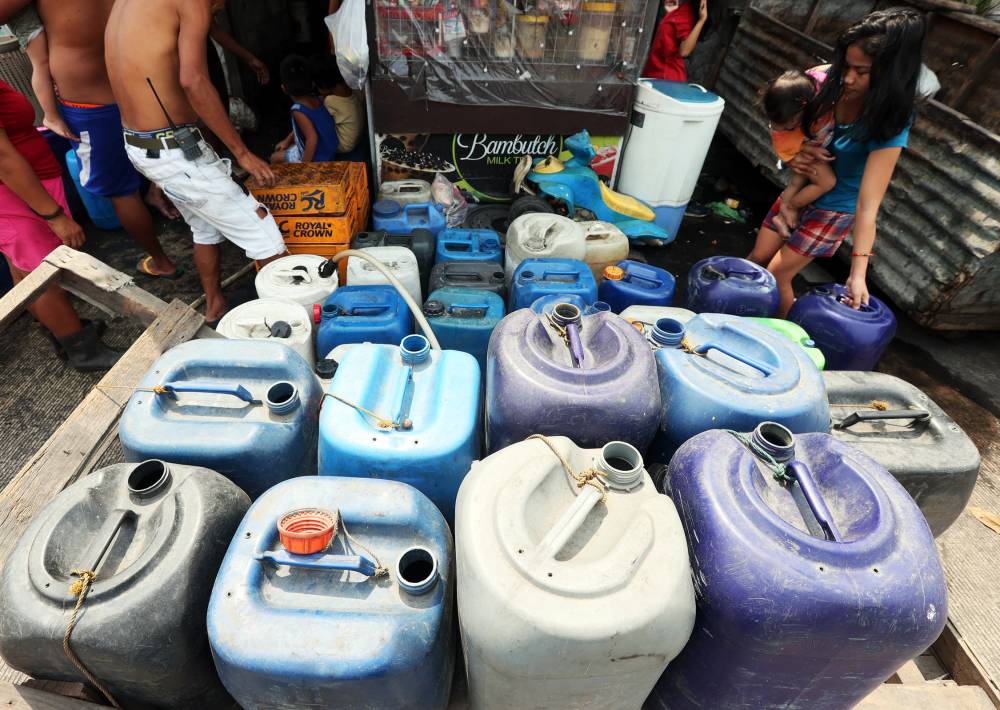Metro folk may feel drop in water supply mid-April

Taps at home will not run dry as the summer peaks next month, but expect the pressure level to be much lower as the supply allocation from Angat Dam—the primary source of water for Metro Manila and adjacent areas— will be reduced by mid-April.
While the National Water Resources Board (NWRB) has retained the 50 cubic meters per second (cms) being allotted to the Metropolitan Waterworks and Sewerage System (MWSS) for household use from April 1 to 15, this will be slashed to 48 cms between April 15 and 30 due to the dry spell caused by the El Niño weather phenomenon.
Just the day before, MWSS spokesperson Patrick Dizon announced at the government’s televised “Bagong Pilipinas Ngayon” briefing that water supply for the whole month of April would be kept at 50 cms.
On the sidelines of an event in Muntinlupa City on Wednesday, however, NWRB Executive Director Ricky Arzadon said the NWRB board decided to reduce it to manage the depleting supply of Angat Dam in light of the dry spell.
Arzadon said the allocation coming from Angat might be changed depending on the water level in the dam.
Based on the latest forecast by the Philippine Atmospheric, Geophysical and Astronomical Services Administration (Pagasa), El Niño is projected to persist until May this year.
As of March 20, Pagasa reported that Angat Dam’s reservoir water level has dipped to 200.99 meters from 201.23 meters the previous day. This was below the normal or comfortable water level of 212 meters.
Managing consumption
Ronald Padua, Maynilad Water Services Inc. head of water supply operations, said the West Zone concessionaire understood the rationale behind the NWRB’s decision to maintain the availability of water, especially during the summer months.
“We need to preserve water from the dam to get through the summer months or sustain water supply before the rainy season begins. Hopefully by June, the rainy season will begin to fill our reservoir,” Padua said.
The decrease in water allocation by the middle of April would not lead to water interruptions, but Padua said water pressure coming from faucets would be lowered during off-peak hours from 10 p.m. to 4 a.m. to mitigate losses in the water system as well as manage the consumption of customers.
The MWSS earlier explained that under normal conditions, water pressure is maintained at a level enough to reach the second floor of houses. With this strategy of lowering the pressure, it said water supply would reach only the first floor.
Angat Dam supplies around 90 percent of Metro Manila’s requirements as well as the irrigation needs of farmlands in Bulacan and Pampanga provinces.
The NWRB releases raw water from the dam to the MWSS, which is then split between concessionaires Manila Water Co. Inc. and Maynilad.
Stop-gap measures
Maynilad receives a bigger share from the dam because it has more customers.
In a bid to mitigate the impact on households, Padua said they have deployed 129 static tanks, which are larger than the usual tanks installed in households, in elevated areas such as Caloocan, Quezon, Malabon, Navotas, Parañaque and Muntinlupa cities to make it easier to supply water to its customers.
Maynilad also inaugurated on Wednesday a modular treatment plant in Muntinlupa City that would treat raw water from Laguna Lake.
The facility, which can produce 20 million liters a day (MLD), uses state-of-the-art ceramic ultrafiltration technology, a “first” for water treatment in the Philippines.
It augments Maynilad’s three existing treatment facilities in Muntinlupa that also source potable supply from the lake.
“The 20-MLD water supply from this additional facility will help improve service reliability for Maynilad customers in the south, as its technologically advanced treatment processes ensure sustained production despite abrupt fluctuations in the lake’s raw water quality, which have been occurring with more frequency owing to climate change effects,” it said.
The government has also readied 137 deep wells in Metro Manila that may be activated as a “contingency measure” once residents experience weaker water pressure or shortage.
Farm losses at P1.75B
The agriculture sector is experiencing the brunt of the dry spell, posting P1.75 billion in damage as crops continue to reel from parched farms, the multiagency task force created to address the weather problem announced on Wednesday.
But Assistant Secretary Joey Villarama, spokesperson for Task Force El Niño, clarified that the damage sustained by the country this year was “minimal” compared with that suffered during the three other “strong and mature El Niño” events in 1997, 2009 and 2015.
“So compared to the figure we have now, it’s P1.75 billion—this is minimal but of course, this doesn’t mean we are downplaying its impact on our farmers,” he said.
Villarama cited the data disclosed by the Department of Agriculture (DA) during the task force’s meeting in Camp Aguinaldo in Quezon City on Tuesday.
“So the focus of Task Force El Niño now is how we can help the estimated 30,000 farmers in eight regions who were adversely affected, especially on how they can recover from their losses due to the damaged crops,” he noted.
“So there are those that experience dry spell, dry conditions and drought; a total of 30 provinces, the highest number, has reported experiencing drought,” he added.
Based on the latest DA monitoring, 67 provinces in eight regions nationwide already feel the effects of the severe El Niño at various levels, Villarama said.
These regions include Ilocos, Cagayan Valley, Central Luzon, Calabarzon (Cavite, Laguna, Batangas, Rizal, Quezon), Mimaropa (Mindoro, Marinduque, Romblon, Palawan), Western Visayas, Zamboanga Peninsula and Central Mindanao.
Villarama said that while the effects of strong El Niño have begun to wane, the country has yet to endure the next three months that he noted were “critical.”




















